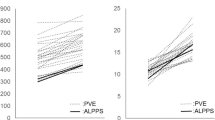Abstract
Background
Preoperative portal vein embolization (PVE) is used to increase the future remnant liver (FRL) in patients requiring extensive liver resection. Computed tomography (CT) volumetry, performed not earlier than 3–6 weeks after PVE, is commonly employed to assess hypertrophy of the FRL following PVE. Early parameters to predict effective hypertrophy are therefore desirable. The aim of the present study was to assess plasma bile salt levels, triglycerides (TG), and apoA-V in the prediction of the hypertrophy response during liver regeneration.
Methods
Serum bile salt, TG, and apoA-V levels were determined in 20 patients with colorectal metastases before PVE, and 5 h, 1, and 21 days after PVE, as well as prior to and after (day 1–7, and day 21) subsequent liver resection. These parameters were correlated with liver volume as measured by CT volumetry (%FRL-V), and liver function was determined by technetium-labeled mebrofenin hepatobiliary scintigraphy using single photon emission computed tomography.
Results
Triglyceride levels at baseline correlate with volume increase of the future remnant liver (FRL-V) post-PVE. Also, bile salts and TG 5 h after PVE positively correlated with the increase in FRL volume (r = 0.672, p = 0.024; r = 0.620, p = 0.042, resp.) and liver function after 3 weeks (for bile salts r = 0.640, p = 0.046). Following liver surgery, TG levels at 5 h and 1 day after resection were associated with liver remnant volume after 3 months (r = 0.921, p = 0.026 and r = 0.981, p = 0.019, resp). Plasma apoA-V was increased during liver regeneration.
Conclusions
Bile salt and TG levels at 5 h after PVE/resection are significant early predictors of liver volume and functional increase. It is suggested that these parameters can be used for early timing of volume assessment and resection after PVE.



Similar content being viewed by others
References
Abulkhir A, Limongelli P, Healey AJ et al (2008) Preoperative portal vein embolization for major liver resection: a meta-analysis. Ann Surg 247:49–57
Kusaka K, Imamura H, Tomiya T et al (2004) Factors affecting liver regeneration after right portal vein embolization. Hepatogastroenterology 51:532–535
Kusaka K, Imamura H, Tomiya T et al (2006) Expression of transforming growth factor-alpha and -beta in hepatic lobes after hemihepatic portal vein embolization. Dig Dis Sci 51:1404–1412
de Graaf W, van den Esschert JW, van Lienden KP et al (2009) Induction of tumor growth after preoperative portal vein embolization: is it a real problem? Ann Surg Oncol 16:423–430
Dong X, Zhao H, Ma X et al (2010) Reduction in bile acid pool causes delayed liver regeneration accompanied by down-regulated expression of FXR and c-Jun mRNA in rats. J Huazhong Univ Sci Technol Med Sci 30:55–60
Huang W, Ma K, Zhang J et al (2006) Nuclear receptor-dependent bile acid signaling is required for normal liver regeneration. Science 312:233–236
Makino I, Chijiiwa K, Fukushima K et al (1997) Cholesterol and bile acid metabolism after selective portal vein ligation. J Surg Res 68:91–98
Ueda J, Chijiiwa K, Nakano K et al (2002) Lack of intestinal bile results in delayed liver regeneration of normal rat liver after hepatectomy accompanied by impaired cyclin E-associated kinase activity. Surgery 131:564–573
Vos TA, Ros JE, Havinga R et al (1999) Regulation of hepatic transport systems involved in bile secretion during liver regeneration in rats. Hepatology 29:1833–1839
Hayashi H, Beppu T, Sugita H et al (2009) Increase in the serum bile acid level predicts the effective hypertrophy of the nonembolized hepatic lobe after right portal vein embolization. World J Surg 33:1933–1940. doi:10.1007/s00268-009-0111-6
Delahunty TJ, Rubinstein D (1970) Accumulation and release of triglycerides by rat liver following partial hepatectomy. J Lipid Res 11:536–543
Frank PG, Lisanti MP (2007) Caveolin-1 and liver regeneration: role in proliferation and lipogenesis. Cell Cycle 6:115–116
Newberry EP, Kennedy SM, Xie Y et al (2008) Altered hepatic triglyceride content after partial hepatectomy without impaired liver regeneration in multiple murine genetic models. Hepatology 48:1097–1105
Kluger M, Heeren J, Merkel M (2008) Apoprotein A-V: an important regulator of triglyceride metabolism. J Inherit Metab Dis 31:81–88
Nilsson SK, Heeren J, Olivecrona G et al (2011) Apolipoprotein A-V; a potent triglyceride reducer. Atherosclerosis 219:15–21
Vergoni AV, Scarano A, Bertolini A (1992) Pinacidil potentiates morphine analgesia. Life Sci 50:L135–L138
Avritscher R, De BT, Murthy R et al (2008) Percutaneous transhepatic portal vein embolization: rationale, technique, and outcomes. Semin Intervent Radiol 25:132–145
Shoup M, Gonen M, D’Angelica M et al (2003) Volumetric analysis predicts hepatic dysfunction in patients undergoing major liver resection. J Gastrointest Surg 7:325–330
de Graaf W, van Lienden KP, Dinant S et al (2010) Assessment of future remnant liver function using hepatobiliary scintigraphy in patients undergoing major liver resection. J Gastrointest Surg 14:369–378
de Graaf W, van Lienden KP, van den Esschert JW et al (2011) Increase in future remnant liver function after preoperative portal vein embolization. Br J Surg 98:825–834
Dinant S, de Graaf W, Verwer BJ et al (2007) Risk assessment of posthepatectomy liver failure using hepatobiliary scintigraphy and CT volumetry. J Nucl Med 48:685–692
Vaessen SF, Schaap FG, Kuivenhoven JA et al (2006) Apolipoprotein A-V, triglycerides and risk of coronary artery disease: the prospective Epic-Norfolk Population Study. J Lipid Res 47:2064–2070
Dindo D, Demartines N, Clavien PA (2004) Classification of surgical complications: a new proposal with evaluation in a cohort of 6336 patients and results of a survey. Ann Surg 240:205–213
Marin JJ, Barbero ER, Herrera MC et al (1993) Bile acid-induced modifications in DNA synthesis by the regenerating perfused rat liver. Hepatology 18:1182–1192
Chen WD, Wang YD, Meng Z et al (2011) Nuclear bile acid receptor FXR in the hepatic regeneration. Biochim Biophys Acta 1812:888–892
Wang YD, Chen WD, Huang W (2008) FXR, a target for different diseases. Histol Histopathol 23:621–627
Forte TM, Shu X, Ryan RO (2009) The ins (cell) and outs (plasma) of apolipoprotein A-V. J Lipid Res 50(Suppl):S150–S155
van der Vliet HN, Sammels MG, Leegwater AC et al (2001) Apolipoprotein A-V: a novel apolipoprotein associated with an early phase of liver regeneration. J Biol Chem 276:44512–44520
Azoulay D, Castaing D, Smail A et al (2000) Resection of nonresectable liver metastases from colorectal cancer after percutaneous portal vein embolization. Ann Surg 231:480–486
Barbaro B, Di Stasi C, Nuzzo G et al (2003) Preoperative right portal vein embolization in patients with metastatic liver disease. Metastatic liver volumes after RPVE. Acta Radiol 44:98–102
Elias D, De Baere T, Roche A et al (1999) During liver regeneration following right portal embolization the growth rate of liver metastases is more rapid than that of the liver parenchyma. Br J Surg 86:784–788
Hayashi S, Baba Y, Ueno K et al (2007) Acceleration of primary liver tumor growth rate in embolized hepatic lobe after portal vein embolization. Acta Radiol 48:721–727
Kokudo N, Tada K, Seki M et al (2001) Proliferative activity of intrahepatic colorectal metastases after preoperative hemihepatic portal vein embolization. Hepatology 34:267–272
Mailey B, Truong C, Artinyan A et al (2009) Surgical resection of primary and metastatic hepatic malignancies following portal vein embolization. J Surg Oncol 100:184–190
Pamecha V, Levene A, Grillo F et al (2009) Effect of portal vein embolisation on the growth rate of colorectal liver metastases. Br J Cancer 100:617–622
Ribero D, Abdalla EK, Madoff DC et al (2007) Portal vein embolization before major hepatectomy and its effects on regeneration, resectability and outcome. Br J Surg 94:1386–1394
Treska V, Skalicky T, Sutnar A et al (2010) Portal vein branch embolization in patients with primary inoperable liver tumors. Rozhl Chir 89:456–460
Hoekstra LT, van Lienden KP, Doets A et al (2012) Tumor progression after preoperative portal vein embolization. Ann Surg [in press]
Conflict of interest
There is no conflict of interest disclosure or declaration of funding sources
Author information
Authors and Affiliations
Corresponding author
Rights and permissions
About this article
Cite this article
Hoekstra, L.T., van Lienden, K.P., Schaap, F.G. et al. Can Plasma Bile Salt, Triglycerides, and apoA-V Levels Predict Liver Regeneration?. World J Surg 36, 2901–2908 (2012). https://doi.org/10.1007/s00268-012-1770-2
Published:
Issue Date:
DOI: https://doi.org/10.1007/s00268-012-1770-2




